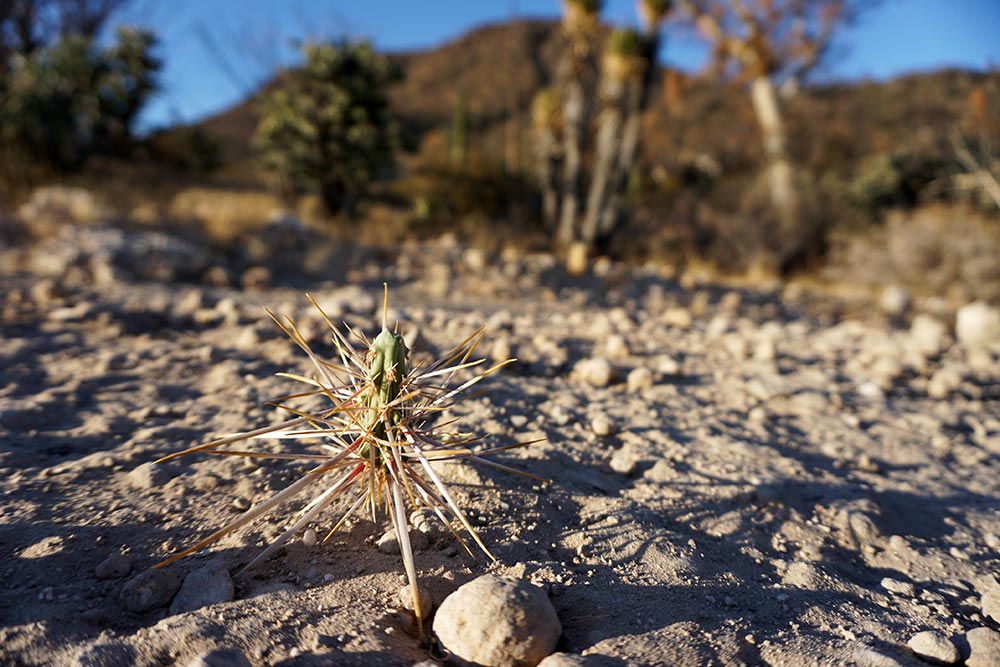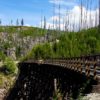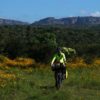How to be met with incredulous stares

How to be met with incredulous stares: Tell people that you’re on your first ever cycling trip and that you’re zig-zagging down the length of Baja California, off-road. Of course, it’s not hard to understand why we received those reactions. I mean, who does such a thing for their first trip, especially in the summer? In hindsight, perhaps we were a bit naive to take on such a challenge. Or more likely, very naive! In our defense, when we first concocted the idea, we were living on our sailboat in the Caribbean which was far away from any desert. Perhaps we were lulled by the sea into thinking that we could do anything but when planning the trip from our floating home, it all seemed fairly simple. Oh, how we would learn!

Our boat in Martinique, where we first conceived our cycling plan.
Looking for a change of pace from our 7 years of full-time Caribbean sailing, my wife and I drew up a plan. That being, to ride the length of the Americas, from Alaska to Argentina, by bike. Having never ridden a bicycle more than 20 miles at any one time, we did the same thing we did to plan for our also-new-to-us-at-the-time sailing adventure: we read. We read a ton of books and online articles, focusing especially on first-hand accounts written by people who had completed similar trips.
How hard could it be?
It was during this planning phase that the first Baja Divide “grand depart” took place, and we followed along on our social media channels with great interest. When riders described the route as difficult, or when we read about their equipment failures or problems with weather, we weren’t put off by it. Instead, we just assumed that it was all status quo, that it must be the same with every cycling trip.

Test riding our new bikes in California.
Having already concluded that we were interested in traveling as far from the busy highways as possible, the Baja Divide looked to be a perfect fit for us. As the weeks went on, one thing led to another and our plan morphed into beginning our ride in California instead of Alaska. We decided to use our daughter’s home as our US base for the month preceding our trip, and to travel south from there, getting our feet wet by riding the Baja Divide.
Painstaking research or dumb luck?
Having never owned a really nice bike – the mountain bikes we owned back in our hometown in Ontario, Canada were not much more than department store models — we deliberated a great deal about what to select for our tour. It’s worth pointing out again that we were making all of our initial equipment decisions from the Caribbean, far from any bike store where we could get our hands on something suitable. I’d like to think that our successful outfitting decisions were all due to our painstaking research, but I have to attribute at least some of it to good luck. Luck, and being smart enough to take the advice of people who had been there and done that.
After much deliberation, we opted to pre-order two Rohloff-equipped Tumbleweed Prospectors, based partly on discussions we had with the bike’s designer, Daniel Molloy, and also on conversations with well-known bikepacking author, Cass Gilbert. We asked to have the bikes set up tubeless with 27.5+ wheels, what we had read was a good solution for the rough, sandy, and often thorny Baja trails, and lacking the experience to do otherwise, largely relied upon Daniel for advice on which other components to use for the bike builds.
With only a hundred or so miles of riding on our new bikes, we set off from Corona, California on a foggy June 1st morning, waving goodbye to our daughter, her husband, and our two grandkids. It took us all of about one hour to get ourselves “lost,” the auto-routing feature of our GPS app having directed us to a road that didn’t exist, leaving us at a standstill in a neighborhood comprised almost entirely of dead-end streets.

Less than an hour into our journey.
That minor fiasco would be repeated several more times before we ultimately got ourselves to the Baja Divide route a couple of days later. From then on it would be smooth sailing, we thought, at least from a navigation point of view. We’d simply have to follow the blue line on our GPS. Yeah, right! There were a few more wrong turns after that point too.
Starting off with a bang!
We had read that the Baja Divide starts off with a bang by forcing riders to ascend Otay Mountain, a 3000′ climb where the difficult portion largely takes place in just a few steep miles. It was here that the severity of what we had undertaken may have been hinted at. As it was, we were still running on adrenaline, and so even though we probably pushed our bikes up about 90% of that climb, we did so with smiles on our faces, imagining the fun to come. Our first wild-camping experience of the trip took place on the downhill side of that mountain, and the US/Mexican border followed the next day. From that point on, it felt as if we were really committed!

There was plenty of bike pushing!
Suffering
I had read quotes from various people who said something to the effect that the longer the cycling tour, the less you need to worry about getting in shape prior to the trip. The idea is that you’d simply condition your legs and your lungs as you toured. While I don’t disagree with that thought process, no one ever added the part about how much you would suffer while acquiring that necessary conditioning. And suffer I did.

How hard could it be? Napping on gravel hard!
My wife has always been a conditioning fanatic. So much so that even though we were traveling with a pretty minimal bikepacking setup, she still insisted on bringing a suspension trainer – an exercise device – with her on the bike, and she used it on a regular basis! I, on the other hand, struggled. From the sore butt that is common for many cyclists, to some knee and elbow issues, the first few weeks were very tough. Fortunately, my conditioning ultimately did improve, and tweaking my seat height and position helped to alleviate most, if not all of the joint issues.
You’ll die out there!
Before we set out on our trip, people were eager to warn us of the heat that we’d experience while riding through the desert in the summertime. Warn us as in, “You’ll die out there!” I’m not going to say that the temperature wasn’t at times uncomfortable, but our biggest nemesis wasn’t the heat itself, it was shade, or rather the lack of it. As virtually every creature in Mexico has learned — man, woman, child and beast — you don’t do anything between the hours of noon and 3:30 PM. Siestas are a thing for a reason… it’s just too hot in the afternoon to work.

Taking advantage of what little shade there is.
Having experienced this for ourselves, it was always our intention to stop riding during those hours, to take a break and resume traveling when the sun’s intensity lessened. The problem is, when there’s no shelter from the sun, it hardly makes any sense to stop. If you can imagine the shape of the average cactus, and then visualize the sun directly overtop of it, you can see that there wouldn’t be a lot of shade created by that combination. Believe me, we tried to make it work. We hid under more thorny, leafless bushes than I care to count. Unfortunately, aside from setting up our tent, we really had no other good option for creating shade, and thus frequently found ourselves riding on during the midday heat instead of stopping. That was never good for morale.
Water is heavy!
If there is one big challenge with the Baja Divide, trumping even the shade issue, it’s water. Nicholas Carman and Lael Wilcox, the two cyclists who established the route, went to great lengths to provide a detailed resupply list so that riders will know exactly how far they must travel in order to acquire more water. What we quickly determined is that some of the stretches between resupply points are long, especially for newbie riders like us who were unaccustomed to putting in high-mileage days. At times it seemed as if we’d have difficulty making it to the next resupply point, and so to compensate, we often carried a lot of water. At times we carried up to 12 liters each, split between bottles on our forks and down tube, and MSR bladders strapped to our rear rack. Water is heavy so that only added to the challenge! Food was less of an issue but since my wife was determined to not subsist on pasta and rice, we probably found ourselves carrying a bit more food than many other cyclists.
Deciphering the code
When it comes to varied terrain, the Baja Divide has it all. From rocks the size of baseballs and coconuts to sand, silt, water crossings, and the ubiquitous washboard gravel, the route kept us guessing as to what would come next. At some points, the route guide gives hints as to what is in store for riders but it took us several weeks to decipher its code. In time, we learned that “crossing drainages” equaled riding up and down hills, over and over, while “rough road” meant that we’d likely be pushing the bikes.

We never did find Easy Street!
Regardless of the actual terrain, very little of it is what any average person would consider easy. At times, we’d be just a few miles from our goal only to have the track change from hard pack to soft sand, or have the road develop a bone-jarring washboard, slowing our progress to a crawl. We came to refer to these route changes as the Gatekeepers to the towns.
Our only major mechanical
We were fortunate in that we had very little in the way of mechanical issues, perhaps a testament to beginning the route with such a high-quality setup. Our biggest problem, and the only one that forced us to deviate from the route, was a damaged tire. And as luck would have it, this problem occurred on perhaps the least accessible part of the Baja Divide, only a mile or two after being dropped off by a panga, a small local boat, on the eastern shore of the Bahía de Concepción (Bay of Conception). Backtracking was not an option, as our boat Captain had long since left us to return to his home port, nor was hitchhiking, as there simply was no traffic on the remote, sandy track we were following. As we were at many points on the Baja Divide, we were really on our own!

Now, what are we going to do?
No doubt the result of running with too little pressure in the tires, itself a result of my lack of experience, I popped the bead on my front tubeless tire after negotiating a small down-and-up gully, and apparently damaged the tire in the process.
For those not familiar with tubeless setups, and a year ago, I wasn’t, the bead of the tire mates to the rim in such a way that it can hold air, and no inner tube is required. The tires have some liquid sealant inside them which helps the seal to stay intact, and also to stop the flow of air should any small thorns be picked up (larger ones can be repaired with special plugs). Running a tubeless setup does allow you to run lower than normal pressures, a good thing for sandy areas, but when too low, you run the risk of breaking the seal. This is obviously what I had done. No problem, we’ll just fix it, right? Easier said than done.
Unable to reseat the bead of the tire, we dealt with the problem by inserting one of the two spare inner tubes that we were carrying, but that resulted in a further set of problems. Again, my inexperience would come back to bite us in the butt. Before inserting the tube, I had neglected to remove the multitude of thorns that I had picked up in the tubeless tire since beginning the journey (they are impossible to avoid), and thus it received a number of punctures within just a short distance. Did I mention that that was the first time I had ever changed a bicycle tire? It’s true, but we got plenty of practice that day, and then the day to follow.

Almost impossible to avoid sharp plants like this.
Doing what I could to avoid the thorny objects which littered the trail, and stopping to add air often, we limped our way to San Nicholas, some 35 miles away. However, unable to really fix the problem, even with the help of some friendly Tijuana residents that we met who were themselves enjoying Baja on a fishing vacation, and also unwilling to continue the trip without having the tubeless setup restored, we diverted to Loreto to get some professional help.
Taking time to smell the roses
Unlike many of those who have ridden this route so far, we benefited from having an open-ended schedule. This freedom allowed us to stop and enjoy places that we found especially appealing, and also to take a few side trips. Having had so many people recommend that we go there, the first detour that we opted to take was to San Juanico’s Scorpion Bay, a popular site for surfers. Once we’d had our fill of the beach, rather than retrace the steps that we took to get there, we experimented by finding our own path up and over the mountains to rejoin the actual Baja Divide route.

Camping on the beach in San Juanico.
Towards the end of the journey, we also chose to ride the coastal road to Cabo San Lucas at the southern end of the peninsula, the only spot in Baja that, some 10 years earlier, we had previously visited. This, and our diversion to Loreto to deal with our tire issue did force us to leave out a couple of small sections of the actual route, but in spite of that, and given that we spent a full 11 weeks riding in Baja, I still believe that we got the full experience!
This didn’t surprise us
Having traveled a fair amount prior to this trip, if there is one thing that we were not surprised about, it was the friendliness of the Baja inhabitants. We’ve long since learned that there are infinitely more good people in the world than there are bad, and while we do take note of anything significant in the news, we don’t let the doom-and-gloom reporting make us believe that everyone we meet has bad intentions.

A cold beer gifted to us by a passing motorist.
Virtually 100% of the people that we came in contact with showed us nothing but courtesy, and in addition to that, there were countless times when complete strangers would go out of their way to make our day brighter. Whether that was by offering us an unsolicited gift of water or food, or by providing us with shelter for the night or from the midday sun, our trip, special in its own right, was made even more epic because of these acts of kindness.
Would we do it again?
Would we tackle such a challenge all over again? In a heartbeat. Fortunately, we have a very bad memory when it comes to discomfort and suffering, and believe me, there was quite enough of that during this trip! On the other hand, we have a great memory for friendly people and positive experiences, so that tends to be what we focus on.




You two are inspiring .. Baja is a tough ride, but so worth it in so many ways. I thought about you being out there in August when I was pushing up a hill the other day. ( as in “they didn’t die, maybe I’ll survive” )
Thanks for the blog pointer to the Del Angel hotel in Cabo. Was great, and especially fun to respond to waiter’s questions about which resort you’re staying at. ( hotel mexicana tres cuadras a norte ). They liked that !
“they didn’t die, maybe I’ll survive”
That made me smile. Thanks. 🙂
I’m glad you decided to publish this, it was enjoyable to read!
Thanks, Brad!
great writing as usual – glad you posted it!
Thanks, Janice. The post, no doubt, has a different vibe from the things I normally post as it was written for an audience who presumably wouldn’t know our background.